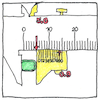Pierre Vernier
metrology

|
Vernier scale
Pierre Vernier added a secondary scale to the moving part of a caliper, where each division on the moving scale is a constant fraction of divisions on the fixed scale. When divisions of the moving or “vernier” scale are nine tenths of the divisions on the fixed scale, then where the vernier scale aligns with the fixed scale gives you tenths to be added to the mark preceding the zero.
Vernier acuity
If humans had a superpower it might be in detecting alignment of lines more accurately than the optical ability of the eye. We can detect differences of alignment smaller than the size of the receptors of our retinae. This hyperacuity gets better with training but worsens with age and changes of attention and may not be the same from eye to eye.
Training a straw man
Some people don’t like to think we need to be trained; instead, we are shown how, or we are taught. We don’t try to herd cats; we don’t put zebras to the saddle. We train dogs, not ourselves. Why don’t we admit, as the most domesticated animal on the planet, we are more like dogs than cats?



Normal venier scales have a Venier constant of 0.02 and a main scale in millimeters, giving an accuracy of two hundreds of a millimeter.
See also in The book of science:
Readings in wikipedia: